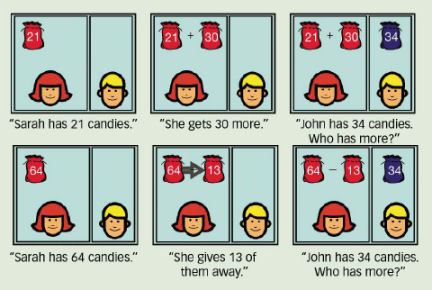Take a Number: Kids show math insights without instruction
Most children need years to master the basics of adding and multiplying single-digit numbers. Yet by the time they enter kindergarten, a new study finds, kids can solve addition and subtraction problems involving large numbers if they are prompted to consult their intuitive knowledge of approximate quantities rather than to compute precise solutions.

Children from a range of social and economic backgrounds, tested either in a laboratory or at school, correctly answered a large majority of such math problems on their own when freed of the requirement for calculating exact results, say psychologist Camilla K. Gilmore of the University of Nottingham in England and her colleagues.
A focus on children’s knowledge of approximate quantities would enhance arithmetic instruction, the researchers propose. “The teachers in our school-based study were skeptical about our experiments and surprised both by their students’ success and by their enjoyment of the tasks,” Gilmore’s group concludes in the May 31 Nature.
The team first tested 20 children, ages 5 to 6 years, from wealthy, highly educated families. Youngsters sat in front of computers that displayed a series of approximate-addition problems, each in three parts.
One problem started with an image of a girl’s face and a boy’s face in separate boxes, with a bag marked “21” above the girl. A caption read “Sarah has 21 candies.” Next, the kids saw an image showing another bag marked “30” above the girl. Its caption read, “She gets 30 more.” A final image displayed a bag marked “34” above the boy. Its caption read, “John has 34 candies. Who has more?”
Children answered nearly three-quarters of such problems correctly. Guessing would have yielded correct responses on only half of the problems.
The researchers then presented similar problems to 37 kindergartners from poor and middle-class families. Children were tested in a hallway outside their public school classroom.
Although the setting offered more distractions than a laboratory, kids still answered almost two-thirds of the problems correctly.
A final laboratory experiment tested 27 kindergartners from wealthy families on two other approximate-math tasks. Subtraction problems appeared in the form: “Sarah has 64 candies. She gives 13 of them away. John has 34 candies. Who has more?” Comparison problems used three boxes per image, containing a girl and two boys, and appeared in the form “Sarah has 51 candies. Paul has 64 cookies. John has 34 candies. Who has more candles, Sarah or John?”
Children correctly solved two-thirds of the subtraction problems and 80 percent of the comparison problems.
The new findings indicate that children can exploit a neural system for estimating quantities—which scientists have also observed in a variety of nonhuman animals—to understand basic arithmetic, remarks psychologist David C. Geary of the University of Missouri–Columbia.
“This is the first study to demonstrate that young children access this system when dealing with relatively complex addition and subtraction problems,” says Geary, who studies mathematical learning.